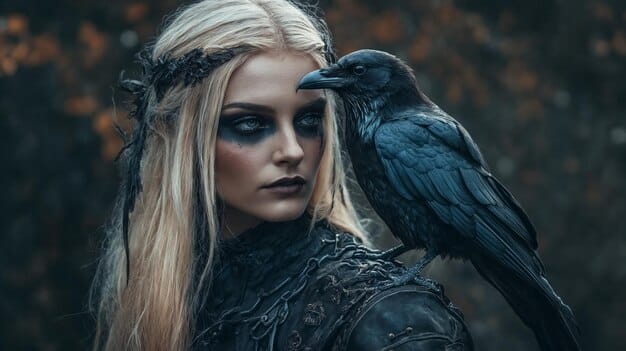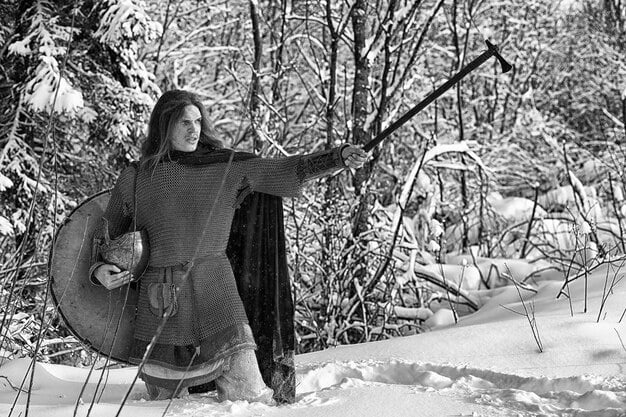Netflix’s ‘The Witcher’ Season 3: Viewership Analysis and Future Impact

Netflix’s ‘The Witcher’ Season 3 experienced a notable viewership, but its reception and completion rates signal important implications for the show’s future direction and the broader landscape of streaming fantasy series.
Netflix’s ‘The Witcher’ Season 3 Viewership: Analyzing the Numbers and Future Implications reveals a complex picture beneath the initial streaming figures, prompting questions about the show’s sustained success and potential adaptations needed for future seasons.
Decoding Netflix’s ‘The Witcher’ Season 3 Viewership
The release of ‘The Witcher’ Season 3 on Netflix was highly anticipated, following the success of previous seasons. However, simply looking at the initial viewership numbers doesn’t tell the whole story. A deeper dive is needed to understand audience engagement, completion rates, and overall reception.
Analyzing the viewership of ‘The Witcher’ Season 3 involves considering a variety of factors beyond the raw hours viewed. These include critical and audience reception, the impact of casting changes, and the competitive landscape of fantasy streaming series.
Initial Viewership Numbers: A Promising Start?
The initial numbers of ‘The Witcher’ Season 3 seemed promising. The season quickly rose to the top of Netflix’s charts, indicating a strong initial interest. But a closer examination reveals that the drop-off rate between Part 1 and Part 2 was quite significant, signalling potential issues with viewer retention.
Critical and Audience Reception: A Mixed Bag
Critical and audience reception played a crucial role in shaping the season’s overall success. While some praised the action sequences and performances, others criticized the plot deviations and pacing issues.
- Positive feedback: Some viewers praised the performances of the lead actors, particularly Henry Cavill in his final season as Geralt.
- Negative feedback: Criticism focused on deviations from the source material, pacing problems, and perceived inconsistencies in character development.
- Impact on viewership: Mixed reviews likely contributed to the drop-off in viewership between Part 1 and Part 2.
The initial viewership masked some underlying issues, hinting at potential problems with the show’s creative direction. High viewership is beneficial, but more crucial is the overall viewer retention, which can indicate long-term success.
The Impact of Henry Cavill’s Departure
One of the most discussed aspects surrounding Season 3 was Henry Cavill’s departure. As the face of the series, his decision to leave had a significant impact on viewer perception and future expectations. This change was unavoidable, however fans have reacted with diverse opinions.
Cavill’s dedication to the source material and his portrayal of Geralt was highly appreciated by many fans. His exit raised concerns about the future direction of the show and the ability of a new actor to fill his shoes.

Fan Reactions and Online Discussions
The announcement of Cavill’s departure sparked numerous discussions on social media and forums. Many fans expressed disappointment and questioned whether they would continue watching the series with a new lead actor.
The Challenge for Liam Hemsworth
Liam Hemsworth has been cast as the new Geralt. He faces a significant challenge in winning over fans who were attached to Cavill’s portrayal. The success of future seasons will depend, in part, on his ability to capture the essence of the character while bringing his own interpretation to the role.
- Adapting to the role: Hemsworth needs to convincingly portray Geralt’s stoicism, combat skills, and moral compass.
- Winning over fans: He must demonstrate a deep understanding and respect for the source material.
- Creating a unique interpretation: While honoring Cavill’s performance, Hemsworth should also bring his own unique perspective to the character.
The departure of Henry Cavill has undeniably cast a shadow on the series. How the show addresses this change and how well Liam Hemsworth embodies the role will be critical factors in determining long-term success.
Analyzing Completion Rates and Viewer Engagement
Completion rates, which measure how many viewers watch an entire season, are a critical metric for Netflix. A high completion rate indicates strong viewer engagement and satisfaction. The Witcher season 3 recorded a drop off, raising questions that need to be addressed.
Analyzing where and why viewers stopped watching provides insights into the strengths and weaknesses of the season. Factors such as pacing, plot development, and character arcs all contribute to viewer engagement and completion rates.
Drop-off Points: Identifying Problem Areas
Identifying specific episodes or plot points where viewership declined can highlight problem areas that need to be addressed in future seasons. Pacing issues or plot inconsistencies can drive viewership away.
Comparison with Previous Seasons
Comparing completion rates with previous seasons provides a benchmark for measuring the season’s success. A significant decline in completion rates could signal a problem with the show’s overall quality or direction.
- Season 1: Strong initial completion rates due to novelty and positive word-of-mouth.
- Season 2: Slight decline in completion rates, possibly due to mixed reviews and perceived deviations from the source material.
- Season 3: Notable decline in completion rates, indicating potential issues with viewer satisfaction and engagement.
Studying completion rate patterns reveals telling data about viewer retention and provides information about areas where the series could improve. It is a tool for series improvement, providing data for future growth.
The Witcher vs. Other Fantasy Series: A Competitive Landscape
The streaming landscape is filled with fantasy series, including ‘House of the Dragon’ and ‘The Lord of the Rings: The Rings of Power.’ These shows compete for viewers’ attention and influence the overall perception of ‘The Witcher’.
Examining how ‘The Witcher’ performs compared to these other series in terms of viewership, critical reception, and cultural impact provides context for understanding its relative success.

‘House of the Dragon’: A Major Competitor
‘House of the Dragon’ became a major competitor with its strong plot lines and powerful characters that were translated from a novel which has a well-established fan base. This contributed to its general success and provided pressure for ‘The Witcher’.
‘The Lord of the Rings: The Rings of Power’: A High-Budget Rival
‘The Lord of the Rings: The Rings of Power’ has set a high bar regarding effects and world-building, establishing it as one of the giants in the fantasy genre. The show came with an already existing large fan base pushing it ahead of the game and creating a competitive atmosphere.
- Production quality: Maintaining high production values to compete with other high-budget fantasy series.
- Storytelling: Crafting compelling narratives that stay true to the source material while appealing to a broad audience.
- Character development: Creating memorable and relatable characters.
To stand out in an increasingly crowded field, ‘The Witcher’ needs to leverage its strengths and address its weaknesses. This involves staying true to its roots while also adapting to the evolving tastes of viewers.
Future Implications for ‘The Witcher’ Franchise
The viewership data and reception of Season 3 have significant implications for the future of ‘The Witcher’ franchise. Netflix must carefully consider these factors when planning future seasons and spin-offs.
Addressing criticisms, managing casting changes, and adapting to the competitive landscape will be crucial for ensuring the long-term success of the franchise.
Addressing Criticisms and Improving Storytelling
Acknowledging and addressing the criticisms leveled against Season 3 is essential. This includes improving pacing, staying true to the source material (while adapting it effectively), and ensuring consistent character development.
Managing the Transition to a New Geralt
The transition to Liam Hemsworth as Geralt must be managed carefully. Netflix needs to support Hemsworth in his new role and assure fans that the essence of the character will remain intact.
- Promotional strategy: Highlighting Hemsworth’s dedication to the role and his understanding of the source material.
- Creative decisions: Ensuring that the writing and directing choices align with Hemsworth’s strengths and vision for the character.
- Fan engagement: Actively engaging with fans and addressing their concerns about the casting change.
Netflix must leverage the strengths of its IP, address criticisms, engage with its fanbase, and maintain high production standards to ensure long-term success.
Strategies for Season 4 and Beyond
Looking ahead, there are several strategies Netflix can implement to improve the reception and viewership of future seasons. In doing so, they can keep old fans and find new fans to enjoy the product. This ensures the longevity of the series and IP.
These include creative adjustments, marketing tactics, and audience engagement initiatives—all aimed at revitalizing the series and ensuring its long-term viability.
Creative Adjustments: Returning to the Source Material
One of the key strategies is to return to the source material more closely. This includes adhering to the plot lines and character arcs established in Andrzej Sapkowski’s books. It can be translated in a way that pleases the fans of the books and the series fans.
Marketing and Promotion: Emphasizing Strengths
Effective marketing and promotion can help to highlight the strengths of the series and build excitement for future seasons. This includes emphasizing the action sequences, the performances of the cast, and the rich world-building.
- Targeted advertising: Focusing advertising efforts on audiences who are likely to be interested in the series.
- Social media engagement: Actively engaging with fans on social media and responding to their feedback.
- Behind-the-scenes content: Sharing behind-the-scenes content to give fans a glimpse into the making of the show.
Adjustments in creative strategy, strategic marketing, strong fan interaction, and dedication to top-notch production are crucial for revitalizing the series and guaranteeing its ongoing appeal.
| Key Point | Brief Description |
|---|---|
| 📉 Viewership Drop | Season 3 saw a noticeable drop in viewership between Part 1 and Part 2. |
| 🤔 Cavill’s Exit | Henry Cavill’s departure impacted fan perception and raises questions about future seasons. |
| ⚔️ Fantasy Competition | ‘The Witcher’ faces stiff competition from series like ‘House of the Dragon’. |
| 🔄 Future Strategies | Returning to the source material and engaging more with fans are crucial for success. |
[Frequently Asked Questions]
▼
Several factors contributed, including mixed critical reception, plot deviations from the source material, and the announcement of Henry Cavill’s departure, which influenced viewer interest.
▼
Cavill’s departure is a major challenge. Liam Hemsworth, the new Geralt, must win over fans. Netflix needs a solid strategy to manage this transition and maintain viewership.
▼
‘House of the Dragon’ and ‘The Lord of the Rings: The Rings of Power’ are major competitors. They offer high-quality fantasy content, setting a high bar for production and storytelling.
▼
Netflix should address criticisms, stick closer to the source material, and support Liam Hemsworth in his role. They also need to engage with fans and improve pacing and character development.
▼
Effective strategies include targeted advertising, active social media engagement, and sharing behind-the-scenes content. Emphasizing the strengths of the series can build excitement.
Conclusion
Analyzing Netflix’s ‘The Witcher’ Season 3 Viewership: Analyzing the Numbers and Future Implications shows that while initial viewership was strong, underlying issues like viewer retention and casting changes pose significant challenges. Netflix’s success in navigating these challenges will determine the future of the franchise.





